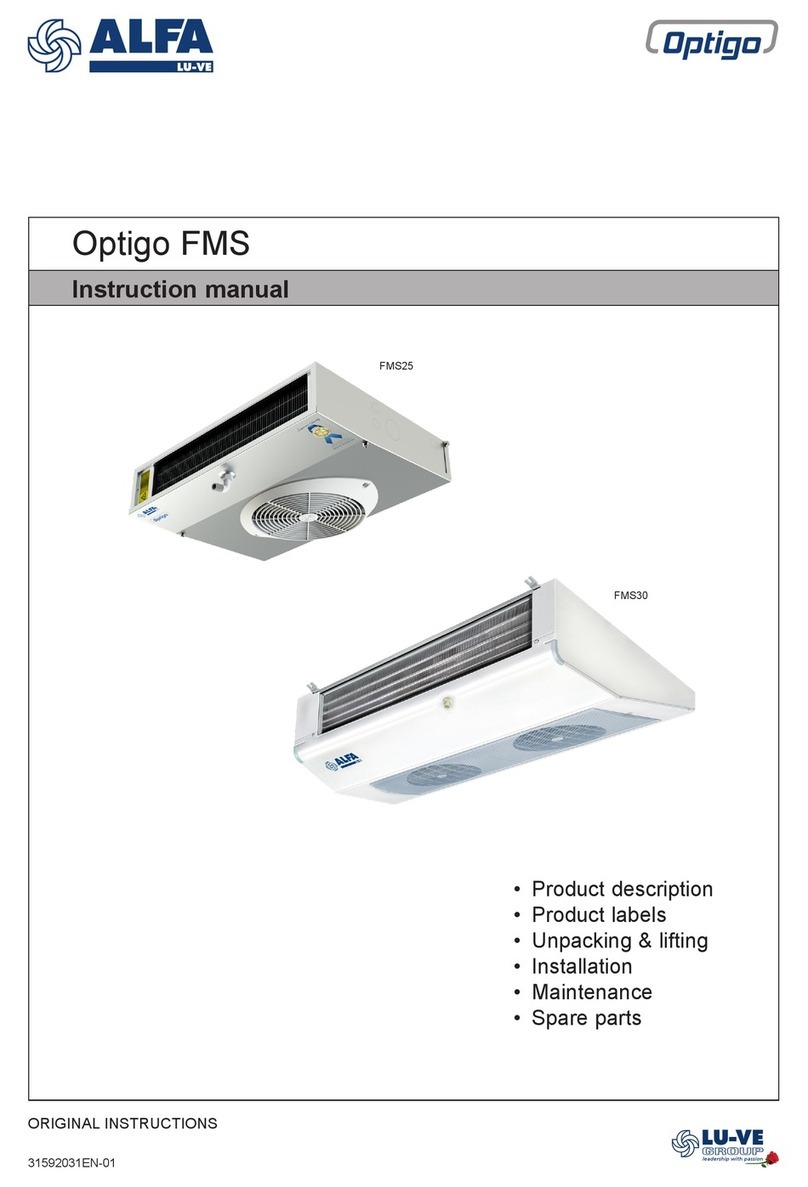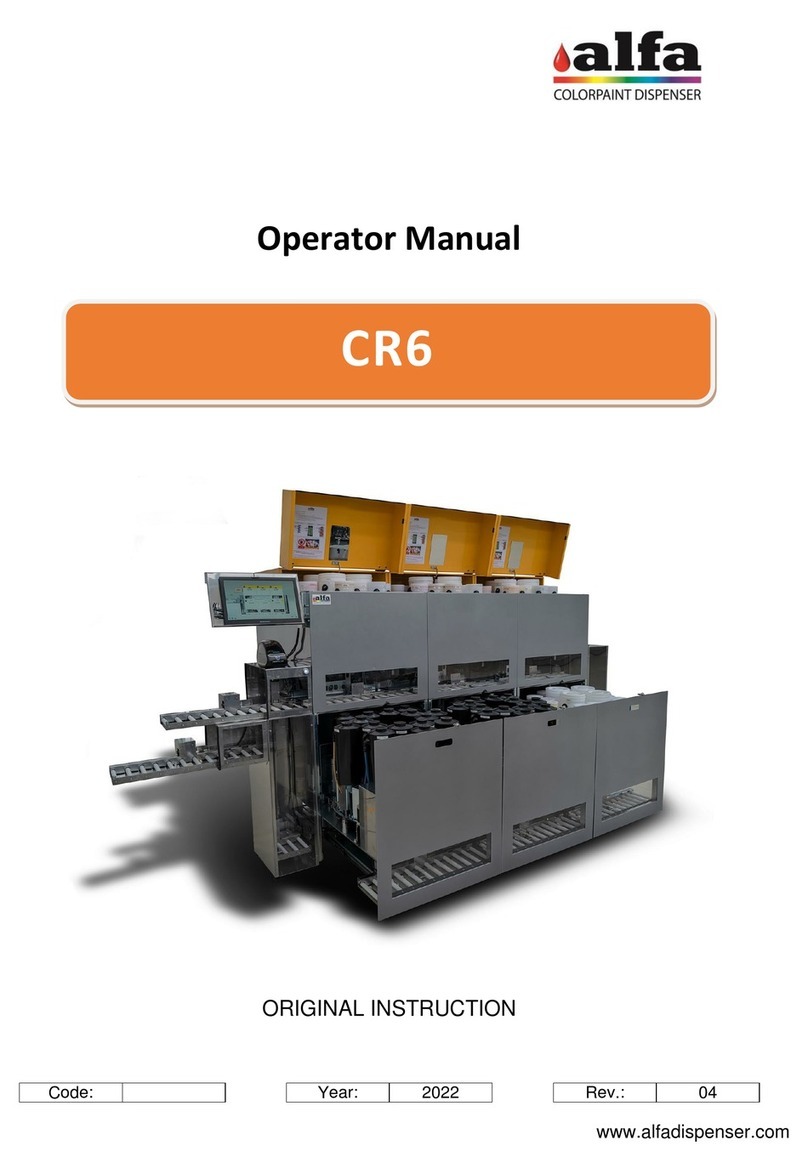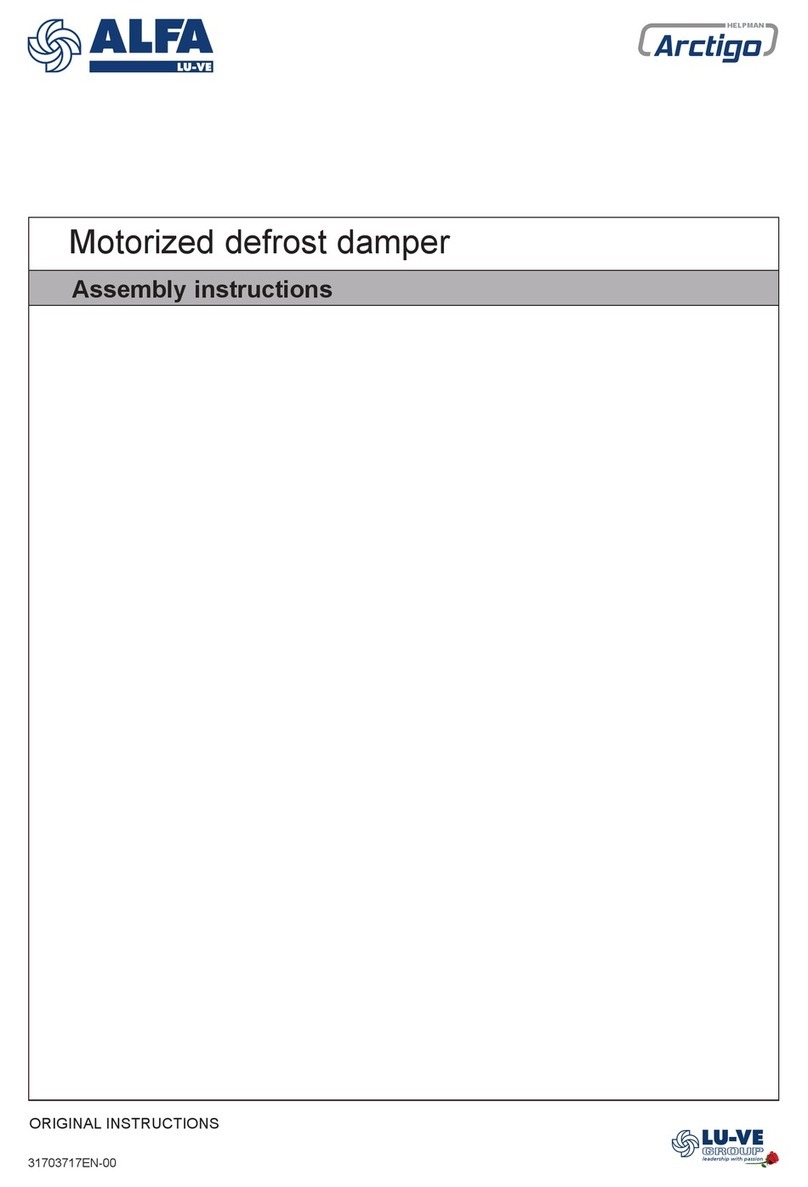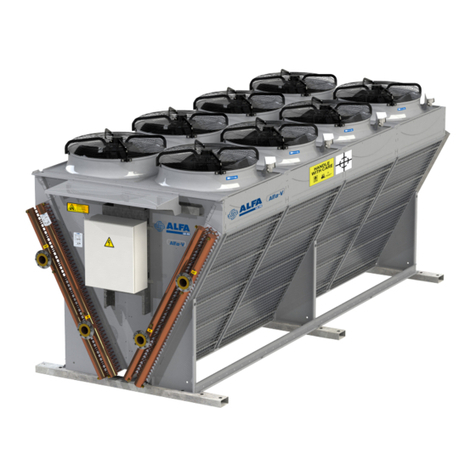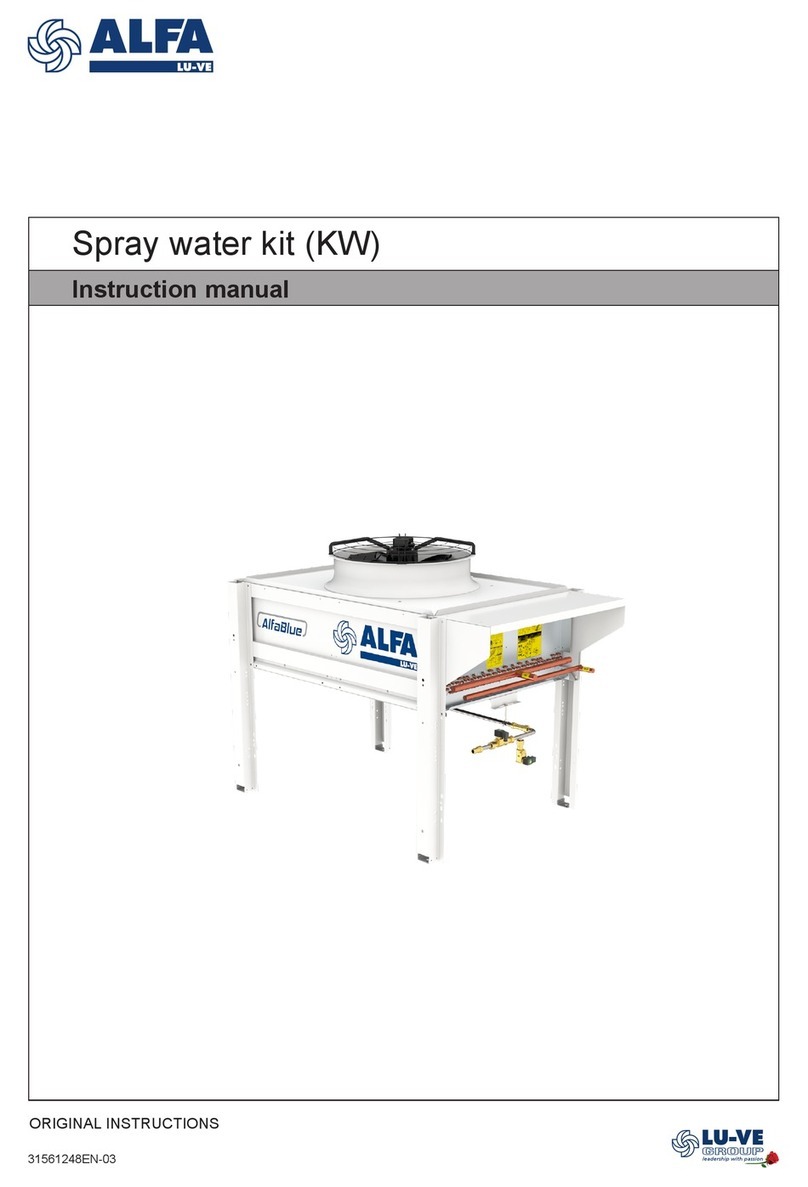Alfa Network CR6 User manual

Technical Manual
TRANSLATION OF THE ORIGINAL INSTRUCTIONS
Code:
Year:
2021
Rev.:
02
www.alfadispenser.com
CR6

Technical Manual – CR6
2
!
"#!

Technical Manual – CR6
"#!
!
3
ENGLISH
Page left intentionally blank

Technical Manual – CR6
4
!
"#!
Alfa Srl
Via Caduti di Ustica, 28 - Calderara di Reno
40012 BOLOGNA – Italy
Tel +39 051 0828494 Fax +39 051 0823283
© Copyright 2015 All rights reserved
© Copyright 2015 All rights reserved
This manual may not be reproduced or modified, either wholly or partially, or translated without the prior authorisation
of Alfa Srl.
IMPORTANT:
Alfa Srl may not be held liable for technical or editorial errors or omissions contained herein.
IMPORTANT:
Alfa Srl may not be held responsible for any errors or damage caused by the use of accessories or spare parts not
specifically approved or guaranteed by Alfa Srl.

Technical Manual – CR6
"#!
!
5
Table of contents
0. FOREWORD ................................................................................................................................................... 7
0.1. HOW TO USE THE MANUAL .................................................................................................................. 7
0.1.1. IMPORTANCE OF THE MANUAL ..................................................................................................... 7
0.1.2. HOW TO KEEP THE MANUAL .......................................................................................................... 7
0.1.3. HOW TO CONSULT THE MANUAL .................................................................................................. 7
0.1.4. SYMBOLS USED IN THE MANUAL .................................................................................................. 8
0.1.5. PROCEDURE FOR UPDATING THE MANUAL IN CASE OF MODIFICATIONS TO MACHINE ...... 8
0.2. INSTRUCTIONS FOR ORDERING ORIGINAL SPARE PART AND CONSUMABLES .......................... 8
0.3. SAFETY INFORMATION ......................................................................................................................... 9
0.3.1. PRECAUTIONS AND USAGE REGULATIONS ................................................................................ 9
0.3.2. GENERAL SAFETY WARNINGS ...................................................................................................... 9
0.3.3. USERS AND ACCESS LEVELS ...................................................................................................... 10
0.3.4. RESIDUAL RISKS AND HAZARDOUS AREAS .............................................................................. 11
0.3.5. CONTACT WITH COLOURANTS .................................................................................................... 11
0.3.5.1. GENERAL FIRST AID MEASURES ................................................................................................. 11
0.4. TECHNICAL SPECIFICATIONS ............................................................................................................ 12
0.4.1. ELECTRICAL SPECIFICATIONS .................................................................................................... 12
0.4.2. EQUIPMENT CLASSIFICATION AND REFERENCE STANDARDS ............................................... 12
0.4.3. OPERATING CONDITIONS ............................................................................................................. 12
1. DESCRIPTION OF THE MACHINE .............................................................................................................. 13
1.1. MAIN COMPONENTS ............................................................................................................................ 13
1.1.1. MAIN COMPONENTS ...................................................................................................................... 13
1.1.2. ROTATING COLOURANT TABLE ................................................................................................... 13
1.1.3. ACCESSING THE GROUPS ........................................................................................................... 14
1.1.4. LOADING AND UNLOADING ROLLER CONVEYORS ................................................................... 15
1.1.5. AUXILIARY FUNCTIONS ................................................................................................................. 16
1.1.6. LIFTERS ........................................................................................................................................... 16
1.1.7. ELECTRICAL CONTROL PANEL .................................................................................................... 17
2. REMOVAL AND REPLACEMENT OF PARTS ............................................................................................ 18
2.0. SAFETY REGULATIONS FOR MAINTENANCE ................................................................................... 18
2.0.1. AUTHORISED PERSONNEL ........................................................................................................... 18
2.0.2. SWITCHING THE MACHINE OFF ................................................................................................... 18
2.0.3. ACCESSING THE REPAIR AND MAINTENANCE OPERATIONS ................................................. 18
2.0.4. RESTORING NORMAL MACHINE OPERATION FOLLOWING MAINTENANCE .......................... 18
2.0.5. DISPOSAL OF PRODUCTS ............................................................................................................ 18
2.1. REMOVING PANELS ............................................................................................................................. 19
2.1.1. SIDE AND REAR PANELS .............................................................................................................. 19
2.1.2. FRONT PANEL ................................................................................................................................ 20
2.2. ACCESSING THE ELECTRICAL PARTS .............................................................................................. 20
2.3. REMOVING COMPONENT CIRCUITS .................................................................................................. 21
2.3.1. CLEANING THE FILTERS ............................................................................................................... 22
2.4. REPLACING THE AUXILIARY ACTUATORS AND SENSORS ............................................................ 23
2.4.1. REPLACING A SENSOR ................................................................................................................. 23
2.4.2. SERVICING/CLEANING THE NOZZLE CLEANING UNIT .............................................................. 23
2.4.3. REPLACING THE HEATER ............................................................................................................. 24
2.4.4. SERVICING THE DISPENSING/RECIRCULATION MOTOR .......................................................... 25
2.4.5. REPLACING THE CERAMIC VALVE DRIVE MOTOR .................................................................... 26
2.4.6. REPLACING THE ROTATING TABLE ROTATION HOME PHOTOCELL ...................................... 27
2.4.7. REPLACING THE DOOR SENSORS .............................................................................................. 27
2.5. REPAIR PROCEDURES ON THE COLOURANT ROTATING TABLE .................................................. 28
2.5.1. REPLACING/ADJUSTING THE ROTATING TABLE MOTOR ......................................................... 28
2.5.2. REPLACING THE STIRRING BELT AND/OR THE DRIVE COUPLING ......................................... 28
2.5.3. REMOVING THE ROTATING TABLE, REPLACING THE BEARINGS AND THE BELT ................ 30
2.7. LIFTER ADJUSTMENTS ........................................................................................................................ 35
2.7.1 LIMIT SWITCH ADJUSTMENT ........................................................................................................ 35
2.7.2 ROLLER CONVEYOR TRANSMISSION O-RING TENSIONING .................................................... 36

Technical Manual – CR6
6
!
"#!
3. ELECTRICAL REPAIR PROCEDURES ....................................................................................................... 37
3.1. DESCRIPTION OF ELECTRONIC PARTS AND DIAGNOSTICS ......................................................... 37
3.1.1. PC BOARD ....................................................................................................................................... 37
3.1.2. MMT BOARD .................................................................................................................................... 38
3.1.3. HUTTS BOARD ................................................................................................................................ 39
3.2. CHECKING AND REPLACING THE NETWORK FUSES ...................................................................... 39
3.3. REPLACING THE SECONDARY CIRCUIT FUSES (INTERNAL TERMINAL BOARDS) ...................... 40
3.4. REPLACING POWER SUPPLIES .......................................................................................................... 41
3.5. REPLACING THE PC AND MAIN BOARDS .......................................................................................... 41
3.6. REPLACING THE HUTTS BOARD ........................................................................................................ 42
3.6.1. CONNECTION VIA VPN CLIENT ON WINDOWS 7 AND 10 .......................................................... 43
3.6.2. CONNECTION VIA VPN CLIENT FROM ANDROID DEVICES ...................................................... 45
4. PROGRAMMING THE ELECTRICAL CIRCUIT BOARDS .......................................................................... 49
4.1. PROGRAMMING BOARDS WITHOUT BOOTLOADER ........................................................................ 49
4.2. PROGRAMMING BOARDS WITH BOOTLOADER ............................................................................... 49
4.2.1. “BOOTLOADERAPP” SOFTWARE .................................................................................................. 49
4.2.2. INSTALLING THE “BOOTLOADERAPP” ......................................................................................... 50
4.2.3. STARTING THE BOOTLOADER ..................................................................................................... 51
4.2.4. UPDATING THE MAB FIRMWARE ................................................................................................. 51
4.2.5. UPDATING THE MMT FIRMWARE ................................................................................................. 51
5. MOVING AND HANDLING THE MACHINE ................................................................................................. 52
6. ACCESSING THE DIAGNOSTIC FUNCTIONS ........................................................................................... 53
6.1. CONTROL AND DIAGNOSTIC INTERFACE ......................................................................................... 53
7. CONNECTION DIAGRAMS .......................................................................................................................... 54
8. DIAGNOSTICS .............................................................................................................................................. 71

Technical Manual – CR6
"#!
$%&"'%&(!
7
0. FOREWORD
0.1. HOW TO USE THE MANUAL
0.1.1. IMPORTANCE OF THE MANUAL
This manual provides instructions on the ordinary and extraordinary maintenance of the product CR6.
Further ordinary maintenance instructions are provided in the Operator Manual.
Before performing any repair or extraordinary maintenance operations, carefully read this manual in all its parts, paying
particular attention to the paragraphs relating to precautions and safety alerts.
If problems or difficulties should arise, the Alfa Srl TECHNICAL SERVICE SUPPORT is always available to provide the
appropriate support, advice, explanation and assistance.
Alfa Srl reserves the right to make modifications to its products, with the purpose of improving their performance, without
prior notification.
Incorrect use of the system can lead to loss of warranty in all its forms and terms.
0.1.2. HOW TO KEEP THE MANUAL
Do not remove, modify or rewrite the contents of this manual for any reason.
Keep the manual in a safe place, protected from heat and humidity.
0.1.3. HOW TO CONSULT THE MANUAL
This manual consists of:
• COVER PAGE IDENTIFYING THE TYPE OF PRODUCT
• TABLE OF CONTENTS
• INSTRUCTIONS AND/OR NOTES ON THE PRODUCT
The COVER PAGE identifies the product described in this manual.
Use the TABLE OF CONTENTS to find the list of CHAPTERS and PARAGRAPHS contained in the manual and the
corresponding topics.
The INSTRUCTIONS AND/OR NOTES ON THE PRODUCT define the safe working practices and advice on the correct
procedures and the skills required to operate the system correctly and maintain it.
Some images of this manual, which have been included for easier identification of the described parts, may not be
exactly the same as the ones in your System.

Technical Manual – CR6
8
$%&"'%&(!
"#!
0.1.4. SYMBOLS USED IN THE MANUAL
The purpose of the safety and information symbols used in this manual is to draw the reader’s attention to warnings
concerning safety or indicating good working practices.
The same symbols are also placed on the machine to indicate dangerous areas and refer to the relevant safety notes in
the manual.
MEANING OF THE SYMBOLS
ATTENTION! GENERIC HAZARD
ATTENTION! HAZARDOUS VOLTAGE
ATTENTION! CRUSHING RISK.
ATTENTION! LASER RADIATION HAZARD
CABLES WITH EARTH CONNECTION
THIS SYMBOL IDENTIFIES THE EARTH CONNECTION REFERENCE POINT.
0.1.5. PROCEDURE FOR UPDATING THE MANUAL IN CASE OF MODIFICATIONS TO MACHINE
If the MACHINE or MANUAL is MODIFIED in any way, an UPDATE may be sent for insertion into the printed Manual.
0.2. INSTRUCTIONS FOR ORDERING ORIGINAL SPARE PART AND CONSUMABLES
To ensure you obtain the correct items as rapidly as possible, please include the following information when placing
your order:
- Machine type: as indicated on nameplate.
- Serial number: as indicated on nameplate.
- Quantity of each item required.
- Part number of required part.
- Description of required part.

Technical Manual – CR6
"#!
$%&"'%&(!
9
0.3. SAFETY INFORMATION
0.3.1. PRECAUTIONS AND USAGE REGULATIONS
The machine must be positioned in an enclosed area that complies with the environmental requirements set out in the
relevant paragraph.
Do not install the machine in a dusty environment.
Do not expose the machine to sources of heat, excessive cold, water, electromagnetic energy, or
sources of smoke.
The machine must be positioned on a completely level surface.
Always make sure that the power cable is intact and free of any cuts or cracks.
In case of cable damage, renew the cable using genuine spare parts.
The noise level generated by the machine is less than 70 DB (measured at a distance of 1 m and at a
height of 1.60 m from the floor).
This value may be exceeded in certain work environments.
If the operator is exposed noise levels potentially exceeding 85 DB on daily basis, effective hearing
protections must be used, as required by the 86/188/EEC regulations.
0.3.2. GENERAL SAFETY WARNINGS
CR6 is compliant with all the safety requirements of the main European and extra-European Standards
and Institutions. Nevertheless, it is recommended that you read carefully the information contained in
the following pages, since it illustrates the potential hazard situations and the necessary precautions to
take.
The machine is provided with doors and guards that prevent the operator from coming in contact with
mechanical and electrical hazardous parts.
A periodical check on the safety devices must be performed according to the instructions provided by
this manual.
If the safety protection systems are damaged, turn off the machine and call the technical service.
High voltage parts - Risk of electric shock
No high voltage parts are accessible from the User area. All the high voltage circuits are housed within
enclosed areas and protected by fixed guards. The high-voltage internal parts are accessible to the
maintenance operator and are protected against direct contact by means of IP 2X or higher class
protection. Hazardous parts are marked by the symbol on the left.
Hazardous mechanical parts - Risk of crushing or entanglement.
Internal moving parts are accessible only to technical personnel. Do not put your hands into the machine
working areas. Tie hair to avoid it becoming entangled in the machine.
For the same reason, avoid wearing loose objects such as ties, necklaces, pendants or other similar
items when working on the machine.
High-temperature parts - Risk of scalding
The machine does not include any components or areas that may reach temperatures high enough to
pose a risk to the user, the maintenance operator or the technician. The areas where this risk could
occur, under fault conditions, are marked by the symbol on the left.
Inflammable parts - Fire risk
In order to minimise the fire risk, the machine is made from materials that do not propagate fire.
Nevertheless, the machine must be installed in a properly ventilated room, complying with the
manufacturer's installation requirements.
Never leave materials, fluid or foreign objects that might increase the risk and spread of a fire inside the
machine.
It is forbidden to modify the internal and external machine protections. If necessary, contact Alfa
Technical Service Support.
Alfa Srl may not be held responsible for any damage that may arise due to the failure to comply with the
above instructions.
In the event of a malfunction, contact the manufacturer's technical support service.

Technical Manual – CR6
10
$%&"'%&(!
"#!
EARTH CONNECTION
Earth conductor connection point.
Always ensure that yellow-green earth leads are securely fastened to the earth point indicated by the
symbol on the left.
DO NOT REMOVE THE EARTH CONNECTIONS FOR ANY REASON.
In the event of damage to the conductors, switch the machine off and immediately contact the technical
service support.
IF THE EQUIPMENT HAS BEEN USED IN A MANNER NOT SPECIFIED BY THE MANUFACTURER, THE
PROTECTION PROVIDED BY THE EQUIPMENT MAY BE IMPAIRED
0.3.3. USERS AND ACCESS LEVELS
The machine has three different user interfaces:
- USER: an operator who uses the machine for the purpose of producing a colour sample;
- MAINTENANCE OPERATOR: user in charge of performing ordinary maintenance operations, such as canister
filling, nozzle cleaning and autocap moisturising;
- TECHNICIAN: an expert operator authorised to access the machine special diagnostic, calibration, configuration,
troubleshooting, and extraordinary maintenance functions.
In order to identify the various areas of intervention, the following definitions must be taken into account:
- USER AREA: the area outside the machine that the user accesses in order to produce a colour sample and to
perform ordinary maintenance operations;
- MAINTENANCE AREA: the area inside the machine, which can be accessed using a key, and where ordinary
maintenance operations are usually performed (on Thor such operations are performed by the MAINTENANCE
OPERATOR); extraordinary maintenance operations require access to the SERVICE AREA and are performed by
the TECHNICIAN (replacement of dispensing units, circuits, electric parts);
SERVICE AREA (FOR USE BY TECHNICIANS): the internal areas of the machine that cannot be accessed
simply with a key but also require other tools (circuits, electrical cabinets);

Technical Manual – CR6
"#!
$%&"'%&(!
11
0.3.4. RESIDUAL RISKS AND HAZARDOUS AREAS
USER AND MAINTENANCE OPERATOR
The potentially dangerous areas associated with mechanical moving parts:
- Colourant table movement*; the rotary movement of
the colourant support base rotation during dispensing
or refill operations does not give rise to any risks that
are not immediately obvious; however, it is advisable
to be careful and not to approach the parts with hands,
arms, hair or clothes during operation.
- Circuit canisters: risk of crushing for arms, hands or
fingers do to the movement of the stirring blades in the
event of a failure or malfunction affecting the panel
opening sensors. Stirring is controlled by a timer and
may start unexpectedly (for example, when the
machine is in diagnostic or refill mode). Do not insert
your hands into the canisters. If necessary, switch the
machine of before carrying out any operation.
Extracting the lower carriage: be careful when refitting
the carriage. Possible crushing risk for hands and
fingers between the fixed and the mobile parts (see
adjacent figure).
TECHNICIAN: The authorised technician can remove the machine fixed protections and access the internal parts
containing live electrical components.
- Electrical panel area: risk of electric shock.
Any intervention that requires the operator to access zones where risks of electric shock are present must be performed
with the machine off.
TECHNICAL SERVICE SUPPORT: The machine may also be operated remotely via a Personal
Computer or Smart device. Pay maximum attention when accessing dangerous areas.
0.3.5. CONTACT WITH COLOURANTS
Always beware of any product leaks from the machine or circuits during production, as well as during cleaning and
maintenance operations.
Contact with the products can cause irritations or injuries if not properly treated.
If necessary, always refer to the safety sheet of the liquid in question, which available from the supervisor.
0.3.5.1. GENERAL FIRST AID MEASURES
In the event of eye contact: remove contact lenses, if present. Immediately rinse the eyes with running water for at least
15 minutes, holding the eyelids open. Seek immediate medical advice.
In the case of skin contact: remove the contaminated garments. Wash the skin thoroughly with soap and water.
Ingestion: seek immediate medical assistance, indicating the container, label or material safety data sheet. Keep the
person warm and relaxed. Do not induce vomiting.

Technical Manual – CR6
12
$%&"'%&(!
"#!
0.4. TECHNICAL SPECIFICATIONS
0.4.1. ELECTRICAL SPECIFICATIONS
Power supply
220Vac ±10% 60Hz or 230Vac ±10% 50Hz
Max current
8.0A
Maximum power consumption
1000W max (+200W AUX panel + 100W internal AUX)
Fuses 5X20 mm
T8.0A-250V Q.ty 2cs
Working noise (*)
Less than 70 dB (A)
(*) A-weighted sound pressure level determined during normal use at a distance of 1 m from the surface of the machinery
and 1.60 m above floor level.
0.4.2. EQUIPMENT CLASSIFICATION AND REFERENCE STANDARDS
Over voltage category
II
See note (1)
Protection rating
IP 20
Equipment classification
I
Reference standards
IEC 61010-1
IEC EN 61326-1
Airborne noise (*)
Less than 70 dB (A)
Note (1):
The equipment is protected against voltage overloads of up to 1500V. For power lines that are subject to transients with
peaks of voltage greater than > 1500V, the use of external suitable protection devices is recommended.
0.4.3. OPERATING CONDITIONS
Operating temperature (*)
+5 - +35°C
Relative humidity
30% - 90% without condensation
Storage temperature
-25 - +55°C
Altitude
2000 m
* The components tend to lose their rheological characteristic outside the manufacturer’s recommended temperature
range. Adhere to the specifications of the components in use.

Technical Manual – CR6
"#!
(")*&+,-+%#!%$!-."!/0*.+#"!
13
1. DESCRIPTION OF THE MACHINE
This paragraph illustrates the main internal and external machine components are describes their respective functions.
1.1. MAIN COMPONENTS
1.1.1. MAIN COMPONENTS
• Colourant groups cabinet
• Colourant groups cabinet (extractable)
• Loading roller conveyor
• Unloading roller conveyor
• Lifters
• Supervisor (User Interface touch screen)
• Electric panel (on rear)
1.1.2. ROTATING COLOURANT TABLE
Each head can house up to 16 colourant groups.
The circuits are placed on a “rotating table”, so that the
product can be dispensed via the various circuits in
sequence.
Each colourant group may be equipped with a 1.5, 2.5 or 3
litre storage canister and its own dispensing unit.
Dispensing is controlled by a single actuator, which is
coupled exclusively to the unit currently in the dispensing
position (in front of the operator). Thus, there is only one
dispensing position for each head, and this is the same
position where it is possible to recirculate the circuit.

Technical Manual – CR6
14
(")*&+,-+%#!%$!-."!/0*.+#"!
"#!
1.1.3. ACCESSING THE GROUPS
The canisters of the groups housed in the upper part of the
machine may be accessed by opening the upper lid (1).
To access the groups in the lower part of the machine it is
necessary to extract the respective carriages (2).
The carriages are maintained in position by a retaining
system consisting of a guides and a magnet.
When closing the carriage and access door, take care to
avoid potential crushing risks.
Extract one carriage at a time: close the open carriage
before opening the adjacent one.
By convention, the heads are numbered (1..6), as shown in
the figure.
The letters A..F are adopted in the software.

Technical Manual – CR6
"#!
(")*&+,-+%#!%$!-."!/0*.+#"!
15
1.1.4. LOADING AND UNLOADING ROLLER CONVEYORS
The container infeed (1) and outfeed (2) roller conveyors are
located on the left hand side of the machine, together with
the outfeed tunnel (3).
The containers may only fed into the machine by means of
the respective shuttles. The shuttle must be selected based
on the volume of the container to be used and is defined
when setting up the machine.
Load the shuttle housing the container manually on the
loading roller conveyor, then generate the start dispensing
command via the Alfa40 software (see Chap. 4 - “HOW TO
PRODUCE A COLOUR” in the user manual).
The machine loads the shuttle by means of the motorised
roller conveyor and checks that the selected volume
corresponds to the volume of the container that has been
loaded.
Once the process is complete, the container is positioned
on the outfeed roller conveyor, where it can be removed
manually.

Technical Manual – CR6
16
(")*&+,-+%#!%$!-."!/0*.+#"!
"#!
1.1.5. AUXILIARY FUNCTIONS
In addition to the rotating colourant table, each head
includes a cleaning station (1), a roller conveyor for moving
the shuttle (2) and an electrical panel (3) that is provides
access to a series of service functions, as described below.
The purpose of the cleaning station is to eliminate any
residual traces of colourant from the dispensing nozzles on
each group, so as to prevent them from becoming blocked.
The following connections are available for each head:
4. IEC320 power socket for connecting a weighing scale
(max. 100 W);
5. Network socket for the PC board
192.168.0.100:8080/admin;
6. USB-A port for connecting the weighing scale (via the
USB-RS232 converter);
7. USB-B port for programming the MMT board;
8. Main power switch for switching the head off and
disconnecting the IEC320 power socket;
ATTENTION: The head 1 switch also switches the supper
visor off.
The upper part of the carriages is also fitted with a heater
(9). This device is activated automatically when the
temperature falls below a programmable threshold, thus
ensuring that the temperature of the components remains
above the minimum limits indicated by the manufacturer.
1.1.6. LIFTERS
The shuttle is transferred from the upper to the lower heads
and to the outfeed by means of two lifters positioned on the
left (1) and right (2) hand sides of the machine.

Technical Manual – CR6
"#!
(")*&+,-+%#!%$!-."!/0*.+#"!
17
1.1.7. ELECTRICAL CONTROL PANEL
This panel is located on the side of the machine and houses the main system electrical connections.
1. On/off Switch
2. Fuse holder 5x20 mm T8 A 250 Vac
3. IEC standard CT-120 power socket
4. 4 x standard C14 connector (200 W MAX*)
5. “192.168.0.100”: RJ45 socket for direct
communication with the machine supervisor
6. “192.168.1.X”: RJ45 socket for local Ethernet
network connection (component heads)
7. “USB”: supervisor USB port
8. Not used
* total power available at the 4 external sockets.
ATTENTION: After switching the machine off, wait 2 minutes before switching it on again (it is necessary to wait until
the internal controllers have shut down).

Technical Manual – CR6
18
&"/%102!0#(!&",20*"/"#-!%$!,0&-)!
"#!
2. REMOVAL AND REPLACEMENT OF PARTS
2.0. SAFETY REGULATIONS FOR MAINTENANCE
2.0.1. AUTHORISED PERSONNEL
The operations described in this chapter require access to hazardous service areas AND MAY BE CARRIED OUT BY
TRAINED AND AUTHORISED TECHNICAL PERSONNEL ONLY.
2.0.2. SWITCHING THE MACHINE OFF
In order to switch the machine off, turn the main switch to its “O” position and disconnect the power cable from the socket.
NOTE: in order to disconnect the machine, the operator must not rely exclusively upon the power switch, but
must also unplug the machine power cable.
2.0.3. ACCESSING THE REPAIR AND MAINTENANCE OPERATIONS
BEFORE ACCESSING THE SERVICE AREA AND, IN GENERAL, BEFORE CARRYING OUT ANY
REPLACEMENT/REPAIR PROCEDURES, DISCONNECT THE POWER CABLE FROM THE MAINS
SOCKET. IT IS ALSO RECOMMENDED TO POSITION THE CABLE SO THAT THE PLUG IS
ALWAYS VISIBLE TO THE OPERATOR DURING THE COURSE OF THE MAINTENANCE
INTERVENTION.
2.0.4. RESTORING NORMAL MACHINE OPERATION FOLLOWING MAINTENANCE
Once the repair procedure has been completed:
• RESTORE ALL THE ELECTRICAL CONNECTIONS
• RESTORE ALL THE EARTH CONNECTIONS
• REINSTALL ANY SAFETY PANELS THAT MAY HAVE BEEN REMOVED
• CONNECT THE MACHINE TO THE MAINS SOCKET
• PERFORM A FUNCTIONAL CHECK (SEE PARAGRAPH 3.4 AND CHAPTER 4 OF THE USER MANUAL)
ALFA MAY NOT BE HELD RESPONSIBLE FOR ANY MACHINE MALFUNCTIONS OR PROBLEMS THAT MAY
ARISE DUE TO THE OMISSION OR INCORRECT EXECUTION OF THE MAINTENANCE OPERATIONS.
2.0.5. DISPOSAL OF PRODUCTS
During the maintenance or repair procedures it may be necessary to empty canisters of the paint contained in the circuits.
Colourants and bases must be disposed of in suitable collector tanks, which must be treated and disposed of
appropriately.
It is forbidden to dispose of the products in the environment or in the public drains.

Technical Manual – CR6
"#!
&"/%102!0#(!&",20*"/"#-!%$!,0&-)!
19
2.1. REMOVING PANELS
To access the colourant groups, the rotating table and stirring movement mechanisms, it is necessary to remove the
covers of the machine as described in this paragraph.
2.1.1. SIDE AND REAR PANELS
On each of the cabinets present in the machine
configuration:
• remove the side panel, if present, by unscrewing
the 6 retaining screws (1).
• remove the rear panel by unscrewing the 6
retaining screws (2) and loosening the 2 lower
supporting screws (3), without removing them.
• lift the panel off the two lower supporting screws.

Technical Manual – CR6
20
&"/%102!0#(!&",20*"/"#-!%$!,0&-)!
"#!
2.1.2. FRONT PANEL
To remove the front panel, in order to access and remove
the groups, proceed as follows:
• Unscrew the 2 retaining screws (1) at the top of
the panel using a suitable Allen key;
• Lift the panel off.
• Unscrew the retaining screws present in the inner
part of the safety panel (3) using a suitable Allen
key;
• Slide the safety panel (3) out.
2.2. ACCESSING THE ELECTRICAL PARTS
Inside the rear removable panel of the machine there is an
electric box that houses:
1. power supply unit, 100-240Vac, 24Vdc
2. power supply unit, 100-240Vac, 48Vdc
3. circuit protection fuses
4. MMT board
5. Raspberry board (Supervisor)
6. Raspberry board (Head)
7. battery
1
1
2
2
2
2
3
5
6
3
1
4
2
7
Other manuals for CR6
2
Table of contents
Other Alfa Network Industrial Equipment manuals
